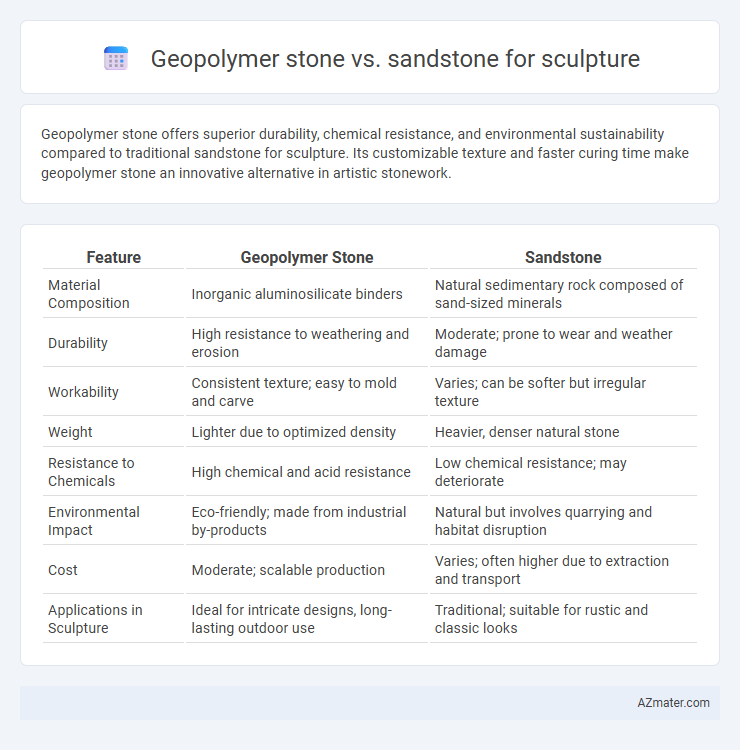Geopolymer stone offers superior durability, chemical resistance, and environmental sustainability compared to traditional sandstone for sculpture. Its customizable texture and faster curing time make geopolymer stone an innovative alternative in artistic stonework.
Table of Comparison
| Feature | Geopolymer Stone | Sandstone |
|---|---|---|
| Material Composition | Inorganic aluminosilicate binders | Natural sedimentary rock composed of sand-sized minerals |
| Durability | High resistance to weathering and erosion | Moderate; prone to wear and weather damage |
| Workability | Consistent texture; easy to mold and carve | Varies; can be softer but irregular texture |
| Weight | Lighter due to optimized density | Heavier, denser natural stone |
| Resistance to Chemicals | High chemical and acid resistance | Low chemical resistance; may deteriorate |
| Environmental Impact | Eco-friendly; made from industrial by-products | Natural but involves quarrying and habitat disruption |
| Cost | Moderate; scalable production | Varies; often higher due to extraction and transport |
| Applications in Sculpture | Ideal for intricate designs, long-lasting outdoor use | Traditional; suitable for rustic and classic looks |
Introduction to Sculptural Materials
Geopolymer stone offers enhanced durability and weather resistance compared to traditional sandstone, making it a favorable choice for outdoor sculptures exposed to harsh environments. Composed of aluminosilicate materials activated by alkaline solutions, geopolymer stone mimics natural stone properties while providing improved strength and reduced porosity. Sandstone, a sedimentary rock with varying grain sizes, remains popular for its natural texture and ease of carving, though it may face erosion and degradation over time when used in sculptural applications.
What is Geopolymer Stone?
Geopolymer stone is an advanced synthetic material created by chemically activating aluminosilicate powders with alkaline solutions, resulting in a durable and environmentally friendly stone-like composite. Unlike natural sandstone, which is formed through sedimentary processes and contains varying mineral compositions, geopolymer stone offers consistent density, superior resistance to weathering, and enhanced mechanical strength ideal for detailed sculpture work. Its customizable properties and lower carbon footprint make geopolymer stone an innovative alternative to traditional sandstone in artistic and architectural applications.
Understanding Sandstone in Sculpture
Sandstone is a sedimentary rock composed primarily of sand-sized mineral particles, predominantly quartz and feldspar, which provides natural texture and color variations ideal for detailed sculptural work. Its porosity and relatively softer composition compared to other stones allow for easier carving and intricate designs, making it a traditional favorite in sculpture. However, sandstone's susceptibility to weathering and erosion requires careful consideration regarding durability and maintenance when used in outdoor or high-exposure sculptures.
Physical Properties: Geopolymer Stone vs Sandstone
Geopolymer stone exhibits higher compressive strength and superior durability compared to natural sandstone, making it more resistant to weathering and erosion. Its controlled manufacturing process ensures consistent porosity and density, reducing water absorption and enhancing longevity in outdoor sculptures. Sandstone, while valued for its natural textures and color variations, tends to have lower hardness and higher porosity, which can lead to faster degradation under environmental exposure.
Durability and Weather Resistance Comparison
Geopolymer stone exhibits superior durability and weather resistance compared to traditional sandstone, making it ideal for outdoor sculptures exposed to harsh environmental conditions. Its synthetic composition enhances resistance to erosion, moisture, and freeze-thaw cycles, significantly reducing the risk of cracking and surface degradation. Sandstone, while naturally aesthetic, is more porous and prone to weathering, which can compromise the structural integrity and longevity of sculptures over time.
Workability for Artists
Geopolymer stone offers superior workability compared to traditional sandstone, allowing artists to achieve finer details and smoother finishes with less effort. Its consistent texture and hardness reduce tool wear and enable precise carving, making it ideal for intricate sculptures. Unlike natural sandstone, geopolymer stone's uniform composition ensures predictable results, enhancing creative control and efficiency in the artistic process.
Cost Differences and Availability
Geopolymer stone offers a cost-effective alternative to traditional sandstone for sculpture, with manufacturing expenses generally lower due to the use of industrial by-products and synthetic binders. Availability of geopolymer stone is more consistent as it is produced in controlled environments, whereas sandstone's supply can be limited by natural quarrying locations and seasonal accessibility. The reduced material cost combined with predictable availability makes geopolymer stone advantageous for large-scale or commercial sculpture projects.
Sustainability and Environmental Impact
Geopolymer stone offers a highly sustainable alternative to traditional sandstone due to its lower carbon footprint, as it is manufactured using industrial by-products like fly ash and slag, reducing waste and greenhouse gas emissions. Unlike sandstone, which involves environmentally destructive quarrying and depletes natural resources, geopolymer stone promotes circular economy principles by utilizing recycled materials and requiring less energy-intensive processing. Its durability and resistance to weathering extend the lifespan of sculptures, minimizing the need for frequent replacements and thus lowering long-term environmental impact.
Artistic Finishes and Aesthetic Potential
Geopolymer stone offers superior artistic finishes due to its customizable texture, color, and durability, allowing sculptors to achieve intricate details and vibrant hues unattainable with natural sandstone. Unlike sandstone, which is prone to weathering and limited in color variation, geopolymer stone maintains its aesthetic integrity over time, making it ideal for both indoor and outdoor sculptures. The material's versatility enhances the artistic potential by enabling experimental finishes and innovative designs without compromising structural strength.
Choosing the Best Material for Sculpture
Geopolymer stone offers enhanced durability and resistance to weathering compared to natural sandstone, making it an ideal choice for long-lasting outdoor sculptures. Its customizable composition allows sculptors to achieve finer details and consistent texture, while sandstone provides natural aesthetic appeal and warmth due to its unique grain patterns. Selecting the best material depends on the desired balance between durability, workability, and visual character of the sculpture.

Infographic: Geopolymer stone vs Sandstone for Sculpture
 azmater.com
azmater.com